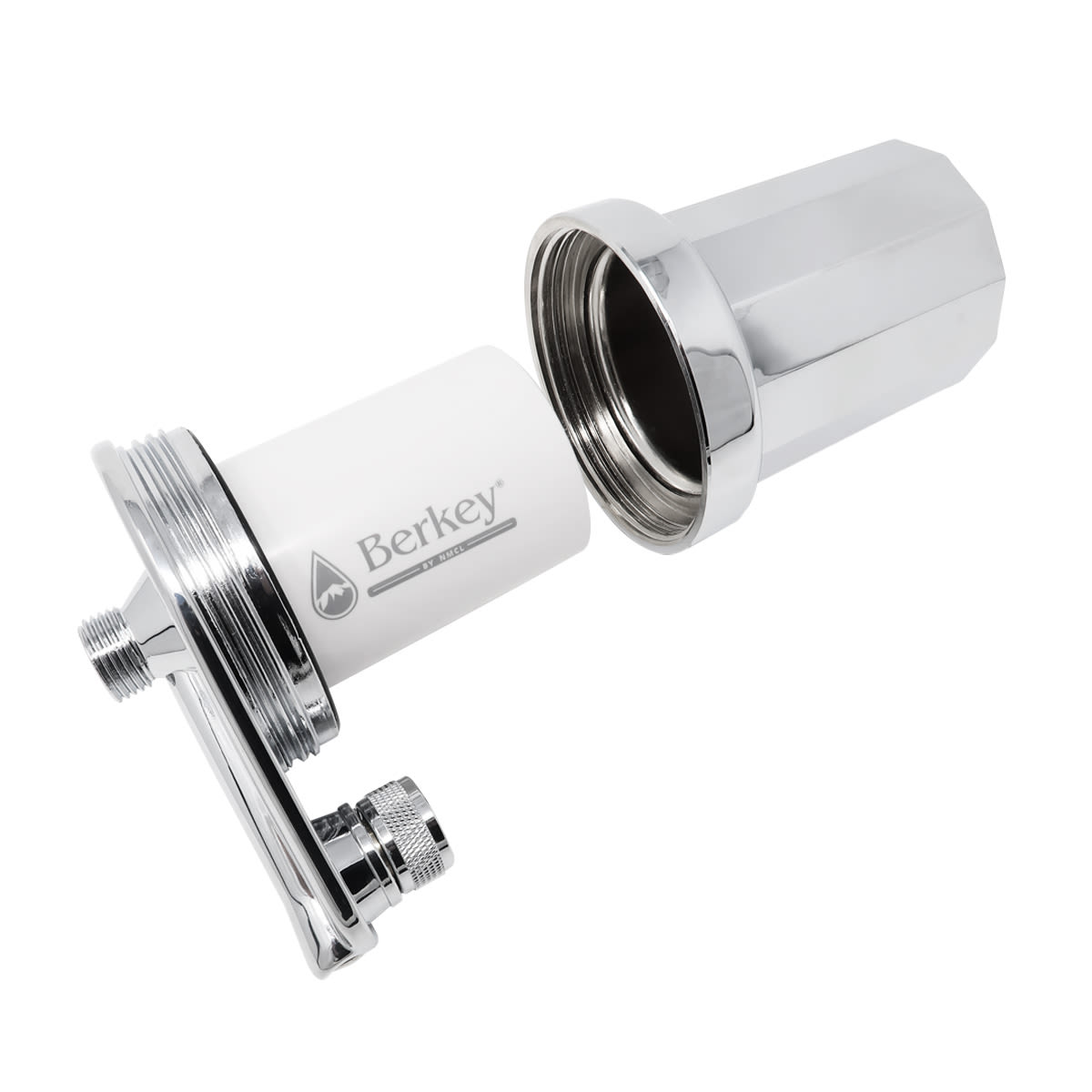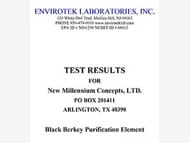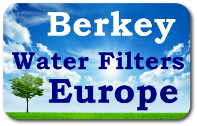Analytical Services, Inc. (ASI)
Microbiological Testing, Research and Consulting
130 Allen Brook Ln., PO Box 515, Williston, VT 05495 USA
1.800.723.4432 / 802.878.5138 Fax: 802.878.6765
www.analyticalservices.com
Subject: Microbiological Challenge Study; ASI Report 36463RAbr
Project Description
The objective of this testing was to establish preliminary data regarding the efficacy of viral removal / inactivation from clean water, in preparation for a full challenge study using NSF P248 Emergency Military Operations Microbiological Water Purifiers (Dec. 2008). Berkey Water provided one Travel Berkey drinking water treatment unit and four (4) Black Berkey Water Filters cartridges for testing. It is understood the unit contains a complex, proprietary filter matrix that treats water from the 1.5 gallon (5.7L) reservoir, and that no true integrity test procedure is currently available to verify the condition of the filter media and proper installation.
The Travel Berkey unit was operated as per manufacturer's instructions. This initial testing was performed using viral (MS2 and fr coliphages) and bacterial (Raoultella terrigena) challenge organisms as per P248 to demonstrate 4 log and 6 log reduction, respectively. (Cryptosporidium, also specified in P248, was not be used in these initial trials as per Berkey Water's instructions). Organisms were propagated as per ASI's standard procedures and stock samples collected prior to use as positive control samples.
The challenge water for the initial trial was municipal supply water (dechlorinated by carbon filtration, filtered to 1 μm nominal and disinfected by UV light, which approximates General Test water).
Prior to testing, each filter element was conditioned with approximately 10 gallons (38 L) of unseeded water. During conditioning, one negative control sample was collected from the unit effluent, and was analyzed for all three test organisms. After conditioning, the reservoir was partially filled with four liters (4 L) and seeded to achieve a pretreatment concentration of approximately 10e6 PFU/mL (coliphage) and 10e7 CFU/mL (bacteria). One influent sample was collected immediately from the unit reservoir. The results form the analysis of this sample established the pretreatment concentrations and were used to calculation log reductions of each organism type.
After approximately 50% of the seeded reservoir volume had been processed, effluent samples were collected. Data from these analyses were used to determine the log reduction achieved. The above testing was performed with a single filter element in place; MS2 and Raoultella were tested first, then the unit was emptied, rinsed, disinfected and a second conditioned filter installed for testing with fr coliphage.
At the end of the MS2 and Raoultella trials, an effluent sample was collected a spiked to serve as a control sample to determine whether anti-microbial agents leach into the effluent water. This is critical in terms of claims of treatment within a specific timeframe. This sample was spiked with a known concentration of MS2 (10e3 PFU/mL) and Raoultella (10e3 CFU/mL). Two samples were collected from this seeded control; one sample was analyzed immediately and the other sample was analyzed after approximately three hours contact time. If no anti-microbial agents are present in the treated water, the results for each organism type at different time points are expected to be similar; if analysis of the second sample indicates a substantially lower concentration, it suggests anti-microbial compounds are present in the effluent water. In this case, the compound(s) would need to be identified and neutralized upon sample collection to generate valid microbiological reduction data as the water leaves the unit.
All samples were analyzed quantitatively as per ASI's standard procedures. Log reductions for each organism type, were calculated as follows:
Log Reduction = Log10( Influent concentration / Effluent concentration )
Results
The results of the testing described above are presented in Tables 1-4, below.
Table 1. Summary of log reductions of MS2, fr and R. terrigena in General Test Water achieved by the Black Berkey filters compared to 248 requirements.
| Sample ID | Log Reduction | P248 Requirement |
|---|---|---|
| (Minimum) | ||
| MS2 | 6.24 | 4.00 |
| fr coliphage | >5.21 | 4.00 |
| R. terrigena | >6.36 | 6.00 |
Table 2. Concentrations of stock microorganisms (MS2, fr and R. terrigena).
| Sample ID | Avg. PFU/mL or CFU/mL |
LOG |
|---|---|---|
| MS2 Stock | 6.40E+09 | 9.81 |
| fr Stock | 8.23E+07 | 7.92 |
| R. terrigena Stock | 3.67E+08 | 8.56 |
| R. terrigena Stock (Day 2) | 9.00E+08 | 8.95 |
Table 3. Results of MS2, fr and R. terrigena in General Test Water, filtered with one Black Berkey element.
| Sample ID | Avg. PFU/mL | LOG | Log Reduction |
|---|---|---|---|
| MS2 Influent | 5.27E+06 | 6.72 | N/A |
| MS2 Effluent | 3.00E+00 | 0.48 | 6.24 |
| fr Influent | 1.64E+05 | 5.21 | |
| fr Effluent | <1 | <0.00 | >5.21 |
| R. terrigena Influent | 4.57E+06 | 6.66 | |
| R. terrigena Effluent | <2 | <0.3 | >6.36 |
Table 4. Summary of leaching test results; MS2 and R. terrigena spiked into product effluent.
| Sample ID | Avg. PFU/mL | LOG | Log Reduction |
|---|---|---|---|
| MS2, T0 | 6.60E+03 | 3.82 | |
| MS2, T+3 hrs | 1.22E+04 | 4.09 | -0.27 |
| R. terrigena, T0 | 3.73E+01 | 1.57 | |
| R. terrigena, T+3 hrs | 2.07E+01 | 1.32 | 0.26 |
Discussion
Flow rate was indicated to be 2.75 gallons per hour (10.4 LPH) with two filter elements installed. The flow rate observed by ASI was approximately 2 LPH. The initial priming was performed as described in the instructions, using the "sport bottle" approach. Although "sweating" was observed over the entire surface of the filters, this did not appear to be completely effective at forcing the air out of the pores of the filter and allowing the expected flow rate. The two filters initially received were re-primed using "priming button" and ASI pressurized reagent water system. This was more effective at priming the filters. The fastest flow rate measured was 200 mL/min or 3.17 GPH.
All controls samples, including stock samples, analytical positive and negative controls, and the negative control collected prior to seeding yielded appropriate results and were accepted.
The results of the leaching control samples (effluent sample spiked with MS2 and R. terrigena and analyzed at two time points) were quite similar, suggesting that no active antimicrobial agent is leaching into the treated water. Please note that the Raoultella concentration was lower than expected due to a low stock concentration, but did not affect the leaching test.
Under the test conditions described, the Black Berkey filters exceeded the minimum log reduction requirements specified in NSF P248 for all three types of microorganisms (Table 1). It was noted that MS2 and R. terrigena were detected in the treated water samples at very low concentrations.
Overall, the unit is well designed and simple to operate, and yielded results that exceeded the target log reduction criteria (4 log viruses, 6 log bacteria) under the clean water test conditions described above. Further testing to determine the performance of the Black Berkey filters under "challenge water" conditions (elevated turbidity, organic carbon, etc.) is recommended as the next step.







